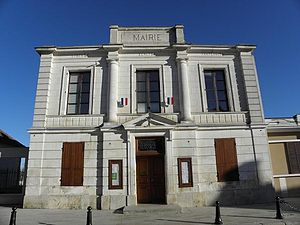Appoigny
| Appoigny | ||
|---|---|---|

|
|
|
| region | Bourgogne-Franche-Comté | |
| Department | Yonne | |
| Arrondissement | Auxerre | |
| Canton | Auxerre-2 | |
| Community association | Auxerrois | |
| Coordinates | 47 ° 53 ' N , 3 ° 32' E | |
| height | 82-201 m | |
| surface | 22.09 km 2 | |
| Residents | 3,167 (January 1, 2017) | |
| Population density | 143 inhabitants / km 2 | |
| Post Code | 89380 | |
| INSEE code | 89013 | |
| Website | http://www.appoigny.com/ | |
 Mairie (Town Hall) |
||
Appoigny is a French municipality with 3167 inhabitants (at January 1, 2017) in the Yonne department ( Region Bourgogne Franche-Comté ). It is located around ten kilometers north of Auxerre city center between the Yonne River and Autoroute 6 . The inhabitants of Appoigny are called Époniens .
history
The origins of today's community are Gallo-Roman lands, which in the 5th century belonged to the family of Bishop Germanus of Auxerre . Under the name Eponiacus (named after the goddess Epona ), Appoigny belonged to the bishops of Auxerre from 448 until the French Revolution . Due to its location on the border between Bourgogne-Franche-Comté and Champagne and on a main route of the Roman Empire , Appoigny experienced stormy times from the start; one after the other, the Huns , the Franks and finally the Normans invaded and sacked the area.
Bishop Robert von Nevers had a first fortress built in the eleventh century. Hugo von Noyer in the twelfth and Guy de Mello in the 13th century expanded the Régennes fortress in a bend in the Yonne. The castle became the residence of the Bishops of Auxerre. It was devastated several times, but each time it was rebuilt more elaborately, most recently by the architect Augustin-Charles d'Aviler in the 18th century. In 1791 it was sold and demolished.
During her journey to Reims , Joan of Arc crossed the Yonne in 1429 at the Gué de la Pucelle ("Jungfernfurt", now a park).
Agriculture and viticulture shaped the economic development of Appoigny. Vegetable growing had such a good reputation that the municipality was nicknamed Le Jardin d'Auxerre ("The Garden of Auxerres"). Even today , a three-day festival is celebrated every year on the name day of St. Fiacrius, the patron saint of gardeners, at the end of August.
Town twinning
- Appoigny maintains a town partnership with Freudenburg in Rhineland-Palatinate .
Attractions
- The parish church of St-Pierre-St-Paul is a former collegiate church built in the Gothic style between 1207 and 1220 on the initiative of Bishop Guillaume de Seignelay of Auxerre, later Bishop of Paris , and consecrated to the Apostles Peter and Paul . She borrowed her patronage from a church that was then about 150 m further south, much older and no longer able to meet the growing demands, which was placed under the patronage of the Evangelist Johannes as St-Jean d'Appoigny on this occasion . The new church was later expanded to include a tower (16th century) and a side chapel on the north side, while the Salle du Trésor for the cathedral treasure was built on the two corner areas between the choir and the transept arms in the south and the one with one in the north Renaissance vaulted sacristy. St-Pierre d'Appoigny was looted during the Huguenot Wars, but escaped the subsequent wave of destruction of the French Revolution , in the course of which the neighboring church of St-Jean d'Appoigny was demolished. Noteworthy is the de under Bishop François Donadieu Auxerre style is Renaissance realized Lettner one, dating from 1606, the specimens preserved of the few in France of its kind.
Personalities
- The best- known Époniens is the football coach Guy Roux , who looked after the AJ Auxerre club for almost 44 years and brought it from the regional amateur class to the French first division.
Web links
Individual evidence
- ↑ Michel Fougerat: Ensemble paroissial d'Appoigny ( Memento of the original of November 26, 2010 in the Internet Archive ) Info: The archive link has been inserted automatically and has not yet been checked. Please check the original and archive link according to the instructions and then remove this notice. , Website of the parish of Sainte Trinité, Appoigny-Monéteau, French

